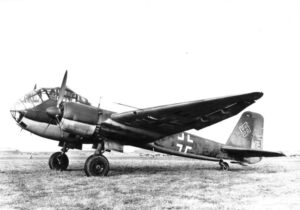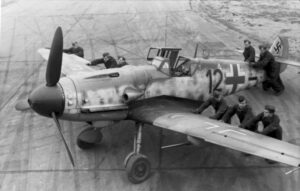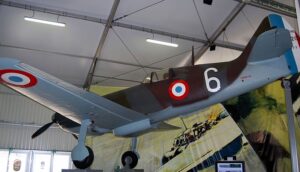Time Period: World War II
Country of Origin: Germany
Type: Fighter Aircraft, Bomber Aircraft, Reconnaissance and Surveillance
Manufacturer: Junkers
Junkers Ju 88 Aircraft Overview
The Junkers Ju 88 was a German twin-engine multirole aircraft that was designed and built by Junkers Flugzeug- und Motorenwerke AG in the 1930s and 1940s. It was one of the most versatile aircraft of the Second World War and served in a variety of roles, including bomber, dive bomber, night fighter, and reconnaissance aircraft.
The Ju 88 had a crew of four and was powered by two Junkers Jumo 211 liquid-cooled engines, which gave it a top speed of around 509 km/h (316 mph) and a range of around 3,000 km (1,864 miles). It could carry a variety of weapons, including bombs, torpedoes, and machine guns, and was often equipped with radar and other advanced avionics for its role as a night fighter.
The Ju 88 was first used in combat in the Spanish Civil War, and went on to see extensive service in the Second World War on both the Eastern and Western fronts. It was highly valued by the German military for its speed, maneuverability, and versatility, and a total of over 15,000 Ju 88s were produced between 1936 and 1945. After the war, some examples of the Ju 88 were used by other countries, including France and Egypt.
Junkers Ju 88 Specifications
- Crew: 4 (pilot, bombardier/front gunner, radio operator/rear gunner, navigator/ventral gunner)
- Length: 14.4 m (47 ft 3 in)
- Wingspan: 20 m (65 ft 7 in)
- Height: 4.8 m (15 ft 9 in)
- Wing area: 54.5 m2 (587 sq ft)
- Empty weight: 9,860 kg (21,737 lb)
- Gross weight: 12,105 kg (26,686 lb)
- Max takeoff weight: 14,000 kg (30,865 lb)
- Powerplant: 2 × Junkers Jumo 211J-1 or 211J-2 V-12 liquid-cooled inverted piston engine, 1,000 kW (1,340 hp) each for take-off. 1,010 kW (1,350 hp) at 250 m (820 ft). 790 kW (1,060 hp) at 5,200 m (17,000 ft).
- Propellers: 3-bladed VDM variable-pitch propeller
Junkers Ju 88 Performance
- Maximum speed: 470 km/h (290 mph, 250 kn) at 5,300 m (17,390 ft) and 12,500 kg (27,557 lb)
- Cruise speed: 370 km/h (230 mph, 200 kn) at 5,300 m (17,390 ft) economical cruising speed
- Range: 1,790 km (1,110 mi, 970 nmi) with 2,896 L (765 US gal; 637 imp gal)
- Ferry range: 2,730 km (1,700 mi, 1,470 nmi) with 4,028 L (1,064 US gal; 886 imp gal)
- Service ceiling: 8,200 m (26,900 ft)
- Time to altitude: 5,400 m (17,700 ft) in 23 minutes
- Wing loading: 220 kg/m2 (45 lb/sq ft)
- Power/mass: 0.100 hp/lb (0.164 kW/kg)
Junkers Ju 88 Armament
- Guns:
- 1 × 7.92 mm MG 81J machine gun on flexible mount in front windscreen, firing forward with 1,000 rounds.
- 1 × 7.92 mm MG 81J machine gun on flexible mount in lower fuselage nose glazing, firing forward with 1,000 rounds.
- 2 × 7.92 mm MG 81J machine guns on flexible mount in the rear of the cockpit canopy, firing aft with 1,000 rounds each.
- 1 × 7.92 mm MG 81Z twin machine gun on flexible mount in the rear ventral Bola position, firing aft with 1,000 rounds.
- Bombs: Up to 1,400 kilograms (3,100 lb) of ordnance internally in two bomb bays rated at 900 kg (2,000 lb) and 500 kg (1,100 lb) or up to 3,000 kg (6,600 lb) externally. Carrying the maximum load usually required rocket-assisted take-off.
Junkers Ju 88 Image Gallery
More Junkers Aircraft

Junkers Ju 52 Tante Ju
The Junkers Ju 52 was a German transport aircraft designed by Junkers used as both an airliner and deployed during World War II.

Junkers Ju 87 Stuka
The Junkers Ju 87 was a German Luftwaffe dive bomber and ground-attack aircraft first flown in 1935 and used during World War II.

Junkers Ju 188 Rächer
The Junkers Ju 188 Rächer was a German high-performance medium bomber used by the Luftwaffe during World War II.
More Luftwaffe Aircraft
The Luftwaffe, the German air force during World War II, fielded a diverse range of aircraft that played critical roles in the conflict. These aircraft encompassed fighters, bombers, reconnaissance planes, transport aircraft, and more. Explore others:

Junkers Ju 87 Stuka
The Junkers Ju 87 was a German Luftwaffe dive bomber and ground-attack aircraft first flown in 1935 and used during World War II.

Dornier Do 335 Pfeil
The Dornier Do 335 was a German heavy fighter built by Dornier during World War II that was predicted to be better than other twin-engines.

Blohm & Voss BV 141
The Blohm & Voss BV 141 (originally known as the Ha 141) was an asymmetrical World War II German tactical reconnaissance aircraft.

Focke-Achgelis Fa 223 Drache
The Focke-Achgelis Fa 223 was a helicopter developed by Germany during World War II and the first one to attain production status.

Messerschmitt Bf 109
The Messerschmitt Bf 109 is a German fighter aircraft and the backbone of the Luftwaffe’s force during World War II.









